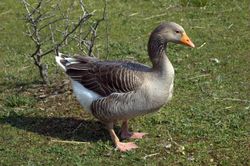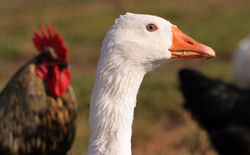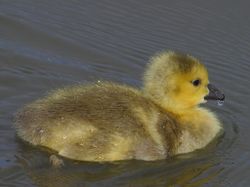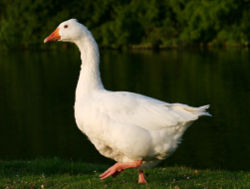
A Danish domesticated Greylag Goose in its pen.

A domestic goose's head
Domesticated geese are descendants of wild
geese now kept as
poultry, used for meat or for their
down feathers.
In Europe and North America, most are derived from the
Greylag Goose. The domestication of this species, as Charles
Darwin remarks (Animals and Plants under
Domestication, i. 287), is of very ancient date.
Few other animals have been bred so largely in captivity
over such a long period, yet has varied so little. The
domesticated goose has changed very little as compared to
say the
domesticated turkey.
It has increased greatly in size and fecundity, but
almost the only change in plumage is that tame geese are
commonly bred to lose the browner and darker tints of the
wild bird, and are more or less marked with white — being
often wholly of that colour.
From the time of the Romans, white geese have been held
in great esteem. Perhaps white geese are preferred because
they look better plucked and dressed.
The most generally recognized breeds of domestic geese
are those to which the distinctive names of Emden and
Toulouse are applied; but a singular breed, said to have
come from
Sevastopol, was introduced into western Europe about the
year 1856. In this the upper plumage is elongated, curled
and spirally twisted, having their shaft transparent, and so
thin

Gosling
that it often splits into fine filaments, which,
remaining free for an inch or more, often coalesce again;
while the quills are aborted, so that the birds cannot fly.
In eastern
Asia, the Swan Goose has been domesticated for centuries, and is
familiarly known as the Chinese Goose.
Geese have proved remarkably resistant to intensive
rearing methods, and they therefore remain an expensive
luxury compared to other poultry, such as the
chicken and
domesticated turkey.
Geese in cooking
Geese can be
roasted as a whole bird, though their size precludes
this preparation except for banquets and other festive meals
(such as on
Christmas). Geese contain much more fat than
turkeys or
chickens do - at least 500 ml (two cups) of fat may be
rendered from an average-sized goose during cooking. The
Cantonese barbecue also features prominently roasted
goose over a charcoal spit with a "tuned" crispy skin.
Geese are used for the production of
foie gras.
Geese produce large edible
eggs, approximately four inches (100mm) from top to
bottom. They can be used in cooking just as ordinary
chicken's eggs, though they have proportionally more yolk,
and this cooks to a slightly denser consistency. Taste is
more or less the same as a chicken's egg.
Geese in fiction and myth

Domesticated goose
When Aphrodite first came ashore she was welcomed by the
Charites (Roman "Graces"), whose chariot was drawn by
geese.
There are Mother Goose tales, such as a farmwife might
have told; there is the proverbial goose that laid the
golden eggs, warning about the perils of greed. And there is
the goose as a veiled reference to the penis in the verses
- Goosy Goosy Gander, where dost thou wander?
- Upstairs, downstairs, in my lady's chamber.
The geese in the temple of Juno on the
Capitoline Hill were said by Livy to have saved Rome from
the Gauls around 390 BC when they were disturbed in a night attack. The
story may be an attempt to explain the origin of the sacred
flock of geese at Rome.
There is a tale of
Trickster and the geese in the North American Trickster
cycle
[1].
Liliane Bodson and Daniel Marcolungo, L'oie de bon
aloi: Aspects de l'histoire ancienne de l'oie domestique
[The goose in ancient life and folklore]. Vise (Musée
Regional d'Archeologie et d'Histoire de Vise), 1994,
discusses the image and lore of domestic geese in classical
antiquity, with a separate chapter on the goose in folklore.
There is a Christian reference (Father Augustine) to the
goose that relates to the coming of the winter solstice or
as it is called "The Great Freezing". One of the reasons for
harsh winter seasons was to scare or cull the goose
population (a creation of the devil). This cyclical process
is supposed to be symbolic of the struggle between evil
(Satan) and God. Evil may never be completely put down, but
God shall always triumph.
One of
Aesop's Fables relates the story of The Goose That Laid
the Golden Eggs, the phrase itself passing into the
language.




